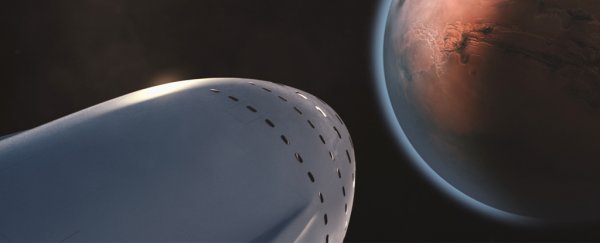In September of 2016, Elon Musk announced the latest addition to the SpaceX rocket family.
Known then as the Interplanetary Transport System (ITS) - now know as the Big Falcon Rocket (BFR) - this massive launch vehicle is central to Musk's vision of sending astronauts and colonists to Mars someday.
Since that time, the space community has eagerly waited for any news on how the preparations for this rocket are going.
Musk further inflamed people's anticipation by recently announcing that the BFR would be ready to conduct orbital flights by as early as 2020.
While admittedly an optimistic deadline, Musk indicated that his company was presently building the ship. And according to a recent post on Musk's Instagram account, a key component (the main body tool) for making the BFR interplanetary spaceship has just been completed.
It is important to note, however, that what is being shown here is not actually a part of the rocket.
As Ryan Whitwam of Extreme Tech noted, what we are seeing in the post is a tool "that SpaceX will use to fabricate the rocket from carbon fiber composite materials that are lighter than traditional materials."
"Flexible resin sheets of carbon fiber will be layered on the tool and then heated to cure them. After heating, you're left with a solid section of rocket fuselage. It's essentially a carbon fiber jig."
Nevertheless, from the size of the tool itself, one gets a pretty clear idea of how large the final rocket will be.
SpaceX chose to illustrate the scale of the tool by placing a Tesla next to it for scale. For some additional perspective, consider the cherry Tesla Roadster (driven by Starman) SpaceX launched with the Falcon Heavy's maiden flight.
Whereas the payload capsule was barely large enough to house it, this car looks like it could fit inside any rocket turned out by this tool easily, and with plenty of room to spare.
And while cars are not exactly the BFR's intended payload, it is good to know that it will be no slouch in that department!
When completed, the BFR will be the largest and most powerful rocket in the SpaceX rocket family.
According to the company's own specifications, it will measure 106 metres (348 feet) in height and 9 metres (30 feet) in diameter and will be able to deliver a payload of 150,000 kilograms (330,000 pounds) to Low-Earth Orbit (LEO) – almost two and a half times the payload of the Falcon Heavy (63,800 kilograms; 140,660 pounds).
And as Musk indicated during an interview with Jonathon Nolan at the 2018 South by Southwest Conference (SXSW) in Austin, Texas, it will even outpace the rockets that won the Space Race for the US:
"This a very big booster and ship. The liftoff thrust of this would be about twice that of a Saturn V (the rockets that sent the Apollo astronauts to the Moon). So it's capable of doing 150 metric tons to orbit and be fully reusable. So the expendable payload is about double that number."
Once completed, Musk hopes to see the BFR performing service missions to Low-Earth Orbit (LEO), the International Space Station, to the Moon, and - of course - to Mars.
 (SpaceX)
(SpaceX)
In addition to sending colonists there as early as the next decade, Musk has also expressed interest in using the BFR to conduct space tourism - flying passengers in luxury accommodations to the Red Planet and back.
In the end, it is clear that Musk and the company he founded for the purpose of reigniting space exploration are determined to make all of this happen.
In the coming years, it will be interesting to see how far and how fast they progress.
This article was originally published by Universe Today. Read the original article.
